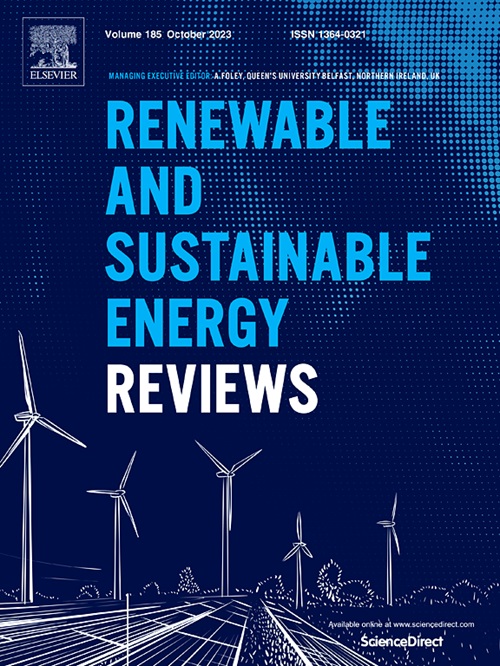评估小水电资源和项目可行性的计算机工具:综述
IF 16.3
1区 工程技术
Q1 ENERGY & FUELS
引用次数: 0
摘要
本文以项目评价的初始评估阶段为重点,对小水电潜力评估、选址规划和设计的计算机化工具进行了分析和比较。这篇综述来自各种来源,包括开放获取的出版物、研究论文和项目、数据存储库和网络资源。本文介绍了目前使用的40多种软件工具,它们的主要特点,比较分析和使用它们的研究,包括对历史软件工具的简要回顾。这些工具可以提供简单的初始估计,也可以是考虑非常规(管道内)水力发电的复杂软件。它们分为四组:i)水轮机选择(4个软件),ii)现场可行性评估(18),iii)环境流量评估(5),iv)基于网络的水电地图集(9)和v)多标准分析(3)。审查强调,虽然有许多现场评估工具,但用于涡轮机选择的新工具的开发,特别是用于创新水轮机,已经下降。报告还指出,在地理信息系统进步的推动下,越来越多地采用数字平台和基于网络的水电制图,这有助于确定可行的水电站选址。本文还讨论了应用多准则分析来评价水电开发的冲突和其他方面的特殊工具。本文强调了用户反馈在改进这些工具中的重要性。它严格审查了现有的工具,总结了最佳做法,并为其在水电资源评估和项目现场可行性评估中的进一步应用和加强提供了指导方针。这篇综述旨在帮助SHP设计者和从业者选择最合适的软件。本文章由计算机程序翻译,如有差异,请以英文原文为准。
Computer-based tools for assessment of small-scale hydropower resources and project feasibility: a review
This article analyses and compares computer-based tools designed for small hydropower (SHP) potential assessment, site planning, and design, focusing on the initial assessment phase of project evaluation. The review draws from various sources, including open-access publications, research papers and projects, data repositories, and web resources. This paper presents more than 40 software tools currently in use, their main features, comparative analysis, and research studies using them, including a brief reminder of historic software tools. These tools can provide simple initial estimates or be sophisticated software considering unconventional (in-conduit) hydro. They are categorised into four groups: i) Hydraulic turbine selection (4 software), ii) Site feasibility assessment (18), iii) Environmental flow assessment (5), iv) Web-based hydropower atlases (9), and v) Multicriteria analysis (3).
The review highlights that while there are numerous tools for site assessment, the development of new tools for turbine selection, particularly for innovative hydro turbines, has declined. It also notes the increasing adoption of digital platforms and web-based mapping for hydropower, driven by advancements in GIS, which aid in identifying feasible hydro sites. Special tools for applying multicriteria analysis to evaluate conflicting and other aspects of hydropower development are also discussed. The paper emphasises the importance of user feedback in improving these tools. It critically reviews the available tools, summarises best practices, and provides guidelines for their further application and enhancement in hydropower resource assessment and project site feasibility evaluation. This review aims to assist SHP designers and practitioners in selecting the most suitable software.
求助全文
通过发布文献求助,成功后即可免费获取论文全文。
去求助
来源期刊

Renewable and Sustainable Energy Reviews
工程技术-能源与燃料
CiteScore
31.20
自引率
5.70%
发文量
1055
审稿时长
62 days
期刊介绍:
The mission of Renewable and Sustainable Energy Reviews is to disseminate the most compelling and pertinent critical insights in renewable and sustainable energy, fostering collaboration among the research community, private sector, and policy and decision makers. The journal aims to exchange challenges, solutions, innovative concepts, and technologies, contributing to sustainable development, the transition to a low-carbon future, and the attainment of emissions targets outlined by the United Nations Framework Convention on Climate Change.
Renewable and Sustainable Energy Reviews publishes a diverse range of content, including review papers, original research, case studies, and analyses of new technologies, all featuring a substantial review component such as critique, comparison, or analysis. Introducing a distinctive paper type, Expert Insights, the journal presents commissioned mini-reviews authored by field leaders, addressing topics of significant interest. Case studies undergo consideration only if they showcase the work's applicability to other regions or contribute valuable insights to the broader field of renewable and sustainable energy. Notably, a bibliographic or literature review lacking critical analysis is deemed unsuitable for publication.
 求助内容:
求助内容: 应助结果提醒方式:
应助结果提醒方式:


